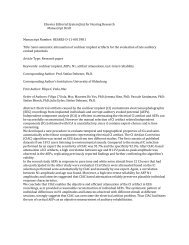Output frequency response function-based analysis for nonlinear ...
Output frequency response function-based analysis for nonlinear ...
Output frequency response function-based analysis for nonlinear ...
Create successful ePaper yourself
Turn your PDF publications into a flip-book with our unique Google optimized e-Paper software.
112<br />
For clarity in discussion, let M ¼ 240, K ¼ 16000, and B ¼ 296, then Eq. (21) can be rewritten as<br />
240 €x ¼ 16000x 296 _x c1 _x 2 x c2 _xx 2<br />
c3x 3<br />
c4 _x 3 þ uðtÞ, (22a)<br />
y ¼ 16000 x, (22b)<br />
Eq. (22a) is a simple case of the NDE model (1) with M ¼ 3, K ¼ 2, c10(2) ¼ 240, c10(1) ¼ 296, c10(0) ¼ 16000,<br />
c30(111) ¼ c4, c30(110) ¼ c1, c30(100) ¼ c2, c30(000) ¼ c3, c01(0) ¼ 1, and all the other parameters are zero.<br />
There<strong>for</strong>e, what is interested in <strong>for</strong> this study is to analyse the effect of the <strong>nonlinear</strong> terms with coefficients c1, c2, c3 and c4 on the system output <strong>frequency</strong> <strong>response</strong>. To achieve this objective, the procedure proposed in<br />
Section 3 are adopted to derive the OFRF of system (22), and the results in Section 4 will be used <strong>for</strong> the<br />
computation of the parametric characteristic of the OFRF with respect to the <strong>nonlinear</strong> parameters c1, c2, c3<br />
and c4. Moreover, though the method proposed in this paper is suitable <strong>for</strong> a general input <strong>function</strong> u(t), yet<br />
<strong>for</strong> convenience in discussion, the input of system (22) is considered to be a sinusoidal <strong>function</strong><br />
u(t) ¼ 100 sin(8.lt). To illustrate the new results more clearly and conveniently, the parameter c2 under the<br />
case of c1 ¼ c3 ¼ c4 ¼ 0 is studied firstly in detail.<br />
(1) Determine the parametric characteristics of OFRF<br />
Note that all the parameters of interest belong to C30, and the other degrees of <strong>nonlinear</strong> parameters are all<br />
zero. Thus Corollary 1 and 2 can be utilised directly. There<strong>for</strong>e,<br />
n 1<br />
CEðHnðjo1; ...; jonÞÞ ¼ c ð Þ=2 d<br />
n 1<br />
2<br />
n 1<br />
2<br />
ð1dð3ÞposðnÞÞ ¼ c<br />
bðN1Þ= ðpþq1Þc c ¼ CEðYðjoÞÞ ¼<br />
CEðHðpþq 1Þiþ1ð ÞÞ<br />
i¼0<br />
¼ 1; c; c 2 h i<br />
ðN1Þ= ðpþq1Þ ; ...; cb c ¼ 1; c; c 2 h i<br />
ðN1Þ=2 ; ...; cb c ,<br />
n 1 ð Þ=2 d<br />
where c ¼ c2. To derive the detailed <strong>for</strong>m <strong>for</strong> c, the largest order N should be determined first according to<br />
Process B in Section 3.2. In order to have a larger range in which the parameters can vary, in this case let<br />
c2A(0,10 8 ). Then the magnitude bound of Yn(jo) can be evaluated as mentioned in Process B. However, <strong>for</strong><br />
paper limitation, the detailed computation is omitted in this case. It can be verified that N ¼ 23 is enough <strong>for</strong><br />
use in this case. There<strong>for</strong>e,<br />
c ¼ 1; c; c 2 h i<br />
ð23 1Þ=2<br />
; ...; cb c<br />
(2) Determination of F(jo) <strong>for</strong> the OFRF<br />
Following Process C, the matrix c ¼½c T<br />
1<br />
¼½1; c2; c 2 2 ; c32 ; c42 ; c52 ; ...; c11 2 Š.<br />
n 1<br />
2<br />
n 1<br />
2<br />
c T<br />
r ŠT should be constructed first. In this case, <strong>for</strong> any 12<br />
different values of c 2, the matrix c is a Vandermonde matrix and thus non-singular. Note that in many cases,<br />
the parameters may be set to be some large values and cover a large range. This will make the element values in<br />
the matrix c extraordinarily large. Then when the inverse of matrix c is computed, there may be some<br />
computation error involved in Matlab. To overcome this problem, c can be written as<br />
bðN1Þ= ðpþq1Þc c ¼<br />
kCEðHðpþq 1Þiþ1ð ÞÞ=k ¼ 1; kðc=kÞ; k 2 ðc=kÞ 2 ðN1Þ=2 ; ...; kb c h i<br />
ðN1Þ=2 ðc=kÞb c .<br />
i¼0<br />
Then Eq. (6) can be written as<br />
ARTICLE IN PRESS<br />
X.J. Jing et al. / Mechanical Systems and Signal Processing 22 (2008) 102–120<br />
Yðjo; cÞ ¼cFðjoÞ T ¼ 1 ðc=kÞ ðc=kÞ 2<br />
ðc=kÞ ‘ j1ðjoÞ; kj2ðjoÞ; ...; k ‘ j ‘ðjoÞ T , (23)<br />
where ‘ ¼ ðN1Þ=2 . Moreover, the range <strong>for</strong> each parameter can be divided into several sub-range, and the<br />
final result is the combination of these results obtained <strong>for</strong> each sub-range. In this study, let k ¼ 10 5 , then<br />
¯c2 ¼ c2=k 2½0; 1000Š. Choose ¯c2 to be the following values to construct c ¼½c T<br />
1 c T<br />
r ŠT , i.e.,<br />
0.1,1,50,65,80,100,150,200,250,300,350,400,450,500,550, 600,650,700,750,800,850,900,950,980,1000. The output<br />
<strong>frequency</strong> <strong>response</strong><br />
h<br />
YYðjoÞ ¼ YðjoÞ1; YðjoÞ2; ...; YðjoÞr i<br />
,

















